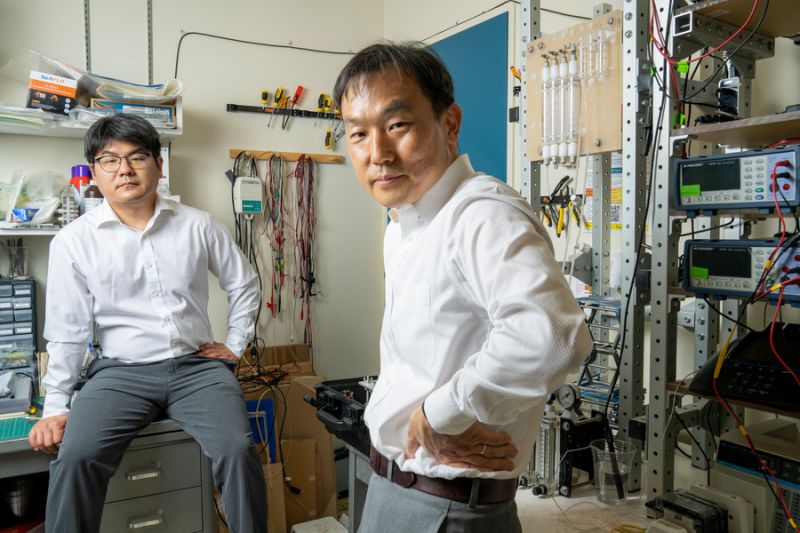From seawater to drinking water, with the push of a button
Published on by Water Network Research, Official research team of The Water Network in Technology
Researchers build a portable desalination unit that generates clear, clean drinking water without the need for filters or high-pressure pumps.
MIT researchers have created a portable desalination unit that can automatically remove particles and salts simultaneously to generate drinking water. “This is really the culmination of a 10-year journey that I and my group have been on,” says senior author Jongyoon Han, right, pictured with Junghyo Yoon, seated.

Credits:Photo: M. Scott Brauer the researchers small unit Caption:The user-friendly unit, which weighs less than 10 kilograms and does not require the use of filters, can be powered by a small, portable solar panel.
MIT researchers have developed a portable desalination unit, weighing less than 10 kilograms, that can remove particles and salts to generate drinking water.
The suitcase-sized device, which requires less power to operate than a cell phone charger, can also be driven by a small, portable solar panel, which can be purchased online for around $50. It automatically generates drinking water that exceeds World Health Organization quality standards. The technology is packaged into a user-friendly device that runs with the push of one button.
Unlike other portable desalination units that require water to pass through filters, this device utilizes electrical power to remove particles from drinking water. Eliminating the need for replacement filters greatly reduces the long-term maintenance requirements.
This could enable the unit to be deployed in remote and severely resource-limited areas, such as communities on small islands or aboard seafaring cargo ships. It could also be used to aid refugees fleeing natural disasters or by soldiers carrying out long-term military operations.
“This is really the culmination of a 10-year journey that I and my group have been on. We worked for years on the physics behind individual desalination processes, but pushing all those advances into a box, building a system, and demonstrating it in the ocean, that was a really meaningful and rewarding experience for me,” says senior author Jongyoon Han, a professor of electrical engineering and computer science and of biological engineering, and a member of the Research Laboratory of Electronics (RLE).
Joining Han on the paper are first author Junghyo Yoon, a research scientist in RLE; Hyukjin J. Kwon, a former postdoc; SungKu Kang, a postdoc at Northeastern University; and Eric Brack of the U.S. Army Combat Capabilities Development Command (DEVCOM). The research has been published online in Environmental Science and Technology.
Commercially available portable desalination units typically require high-pressure pumps to push water through filters, which are very difficult to miniaturize without compromising the energy-efficiency of the device, explains Yoon.
Instead, their unit relies on a technique called ion concentration polarization (ICP), which was pioneered by Han’s group more than 10 years ago. Rather than filtering water, the ICP process applies an electrical field to membranes placed above and below a channel of water. The membranes repel positively or negatively charged particles — including salt molecules, bacteria, and viruses — as they flow past. The charged particles are funneled into a second stream of water that is eventually discharged.
The process removes both dissolved and suspended solids, allowing clean water to pass through the channel. Since it only requires a low-pressure pump, ICP uses less energy than other techniques.
But ICP does not always remove all the salts floating in the middle of the channel. So the researchers incorporated a second process, known as electrodialysis, to remove remaining salt ions.
Yoon and Kang used machine learning to find the ideal combination of ICP and electrodialysis modules. The optimal setup includes a two-stage ICP process, with water flowing through six modules in the first stage then through three in the second stage, followed by a single electrodialysis process. This minimized energy usage while ensuring the process remains self-cleaning.
Attached link
https://www.youtube.com/embed/x0fpwlRPZRYTaxonomy
- Desalination
- Sustainable Desalination
- Desalination
3 Comments
-
very interested in this system especially with the combined solar and ICP concept. Can this be bought now? how much.
-
I have - basically - the same questions. ¿Is it already available for commercial porpuses?... ¿How much does it cost?... We are in Mexico and would like to test the unit before we offer it to our clients. ¿Any contact person to reach?... Regards, JML (juanmlopez@sicolmex.com)
-
do you have a commercial prototype? how much time does it need to treat around 1 m3? how much does the system cost? is it possible to deliver it to the Gaza Strip of Palestine state?